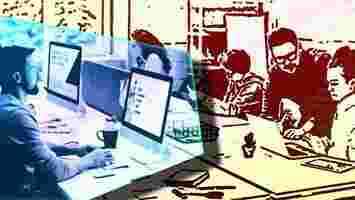How to stop yourself from using the wrong emoji at work
My editor Deb loves to ruin things. One time she used her Ph.D. in Italian to ruin an entire emoji.

The emoji in question is a common Italian hand gesture that, roughly translated, means “what the hell?” This isn’t how our team was using it. At some point, we collectively decided to use this emoji to mean “perfection.”
From what I can gather, people thought it represented kissing your fingertips, the way chefs sometimes do.
Dozens of people used the emoji this way until Deb pointed out the (hilarious) discrepancy. And you know what? Some people still use this emoji to mean perfection. They will probably never stop.
This is a harmless example, but it does point to the inherent ambiguity of emoji — and communication in general. Symbols only have meaning because of a shared cultural context, which means you can’t assume everyone is interpreting emoji the same way. That can lead to some awkwardness — especially in a work context.
Maybe don’t wink at your coworkers
Consider the
3 best practices for a hybrid workplace — from someone who’s done it for years
We have to get rid of our past ideas of what a “normal” business office looks like. As lockdowns ease in the future, there will be industries that want to bring everyone back into an office location even as other companies remain in a fully-remote system.

But there is another option that is poised to become the standard for business operations in the 21st century: the hybrid workplace. In this type of setting, some workers are based in a physical office, while others work from spaces outside of the physical office and can be located anywhere in the world.
Our company has managed a partly-remote team since long before the pandemic began. Since our team members are spread out and not sitting in the office, each department within our company has to consider how decisions and general day-to-day operations impact the management and support of our workforces.
In our years of functioning as a hybrid workplace, we have developed a number of best practices that fall into the following three distinct areas of focus.
1. Remember: People are always number one
With a hybrid workplace, there can be a danger of the remote workers feeling disengaged from the other team members who are in an office together and have the opportunity for impromptu discussions or socializing at the coffee machine.
Fortunately, there are some great things you can do that help to keep all of your employees engaged and feeling like part of the team. We may be cities, states, and sometimes even countries apart, but that doesn’t mean we can’t feel like a team.
I’ve found keeping your team members informed is one way to effectively mimic the feeling of being in an office.
Regular email and text updates on any news affecting your business or personal lives, short video calls, daily team meetings, as well as bi-weekly “all-hands” remote meetings remind team members they are part of something. Political and social updates — for example, regarding new COVID-19 restrictions or simple information such as “where can I still get toilet paper?” — are helpful for expats in particular.
When the pandemic started, companies were quick to realize that protecting their employees should be a top priority. They sent out masks and related personal safety items (e.g., hand sanitizer, etc.). Many companies often send trinkets like gift cards and small gifts at regular intervals, usually related to monthly goal meetings or team-building. This practice should absolutely continue with a hybrid workforce.
Since we’re all using some variation of Slack, one fun activity to raise team spirit is upping the level of competition within and across departments. These online chat tools offer the opportunity to create process-oriented games and virtual events (such as brainstorming or mini-hackathons).
For example, I really enjoyed the idea of a movie challenge that came from one team member. In this challenge, team members took turns in creating a photo or video of a movie, then the other team members guessed what it was.
Regardless of what you choose to do, creating any level of participation keeps your team members engaged and active. Each department in a company can take turns initiating such activities.
2. Support open, clear, and flexible communication
When workers are spread across different time zones, a company needs to adjust its approach to keeping everyone on the same page about projects. Having quick meetings in the conference room won’t work anymore if some of the team members are remote. People’s work schedules will likely be out of sync with each other, perhaps overlapping for only a few hours.
These out-of-sync schedules have led to the rise of “asynchronous communications” — communications that don’t involve an immediate back and forth exchange. Slack and other communication tools like it have made it a lot easier for hybrid workplaces to integrate employees from all over the world, but they won’t magically make your communication good on their own.
So to make sure communication is flowing between in-office and remote staff, I suggest you establish communication rituals, such as a daily standup channel on Slack, or an end-of-day email by team members about their activities and the status of important projects.
Department heads can also have staff “check in” when they start their day and “check out” at the end of the day so that colleagues know when people are available to respond to questions.
While today’s communications tools have given us the ability to send and receive messages at any time of day, that doesn’t mean that every company has to use them in this way. Hybrid workplaces adapt these tools to fit their employees and to ensure efficient communication by setting clear expectations.
During times when it’s “all hands on deck” for projects, managers must clearly convey expectations, so workers know when they should be responding more quickly to communications, or adjusting schedules to allow for more overlap with remote colleagues.
While we’re on the subject of schedules, I can promise you meetings will require a bit more coordination to ensure that everyone who needs to be on the call can be on the call.
When it comes to mimicking “face time” with teammates, video meetings are the simplest solution. You may find that some employees prefer to not have their camera on during calls, and here you will need to be flexible in accepting people’s personal preferences when it comes to sharing images of their home with colleagues.
3. Experiment with processes and workflows
If the chaos of the past several months has taught me anything, it’s that we need to be adaptable. Companies can’t just stick to rigid norms that worked in the past, when everyone was under the same roof together. The best way for your business to successfully incorporate remote workers onto the team is to experiment with different processes and workflows to see which work best for you.
For digital product development teams, it might mean adapting workflows to avoid potential bottlenecks when developers are several time zones away from their project managers. For HR departments, it might mean rethinking your hiring processes to research potential employees who are based in other countries, or adjusting the onboarding process for new hires who are remote.
Of course, there are lots of digital tools out there to assist hybrid workplaces as they strive to keep projects on track. In addition to video conferencing and communication tools, there are also multitudes of project management and document-sharing platforms as well.
In your chosen project management platform, you should experiment with types of setups for keeping track of tasks from creation to completion. For example, some teams prefer timeline views, while other teams find it easier to track tasks when they are organized according to the employee responsible for it. In your project management tool, create different “boards” for different projects or clients to keep things organized, and clearly communicate priorities.
With all these digital tools, security needs to be taken into account — particularly with sensitive project information exchanges and even interviews with potential hires. Before utilizing any digital tools, make sure that you’ve run everything by your IT department (or are following their procedures). The last thing you want during a conversation with an employee or client is to be “Zoom bombed.”
Hybrid workplaces have, as a standard, required flexibility that is being employed in full during this pandemic. We must remember that each team member is different, and has different issues (both at work and in their personal lives) they are dealing with and which we might not be aware of. It is important to treat each team member as an individual.
Transforming your office to a hybrid workplace increases the importance of showing empathy and supporting employee needs, rather than following “business as usual.” An adaptive mindset and use of the right tools, coupled with the right company attitude toward team-building and support for work/life balance, will allow us to emerge from this pandemic better and stronger.
How to recover from burnout and chronic work stress, according to a psychologist
It’s pretty likely you’ve heard of burnout – and you may have even experienced it. Caused by chronic work stress , it’s characterized by signs such as emotional exhaustion, lack of energy, and loss of satisfaction with work – and has been linked to a wide range of physical conditions such as cardiovascular diseases and musculoskeletal pain .

Work stress activates our hormonal, metabolic, immune and cardiovascular systems. If these bodily responses are triggered too frequently, or for too long , they fail to return to normal and may alter our body’s immune and inflammation responses . These changes may eventually cause other physical conditions – such as coronary heart disease .
Although an overhaul of work conditions and culture is needed to address the rise in people experiencing burnout, there are still many things we can do ourselves to deal with it now. The most significant way we can prevent burnout is recovery.
Burnout is a consequence of chronic work stress over extended periods of time. It has three components :
Dealing with burnout is about recovering well from work, rather than focusing on being more productive or better at the work itself. Research continues to show how important it is to recover from work on a daily basis .
Recovery means finding time or space for yourself where you don’t engage in things that are work-related or stressful. Recovery is about bringing physiological responses, such as cortisol (a key stress hormone), back down to baseline levels . Proper recovery helps you feel more energetic and enthusiastic to face another day at work. Recovery can take place both during the workday (internal recovery) and outside of work (external recovery).
Types of recovery
Internal recovery is about giving ourselves relief from stress by using short periods of time during work to reduce our body’s stress responses. This can include taking short breaks, doing breathing exercises, or switching tasks when you’re feeling mentally or physically exhausted. So, if you have a few minutes spare at work between tasks or meetings, you may be better off trying to relax rather than checking your emails and experiencing new stressors.
After work, we have the opportunity for external recovery . These are things we do outside of work to help relieve stress. Instead of keeping on top of work and emails, external recovery may include doing any activities you enjoy. These might include watching TV, reading, or socializing – as long as these activities don’t encourage you to think (and stress) more about work.
The key to good recovery is choosing activities based on how they make you feel. If social media creates negative feelings, don’t check it during your work breaks or after work. If socializing with certain people makes you feel drained, this isn’t going to help you recover.
Daily recovery is also important. Research shows the energy gained from the previous day’s after-work activities helps manage the day’s work stress . But it’s important to know that it’s not the amount of time spent on recovering, but the quality of these activities.
It’s important to do things that make you happy or content as you are doing them – and doing them for yourself. Research has found that picking recovery activities you find personally satisfying and meaningful is more likely to help you feel recovered by the next morning.
Daily recovery activities
Thinking about what you do after work to recover – and whether these activities really are helping you recover – is key. There are four types of recovery experience that explain how and why recovery activities work:
It’s important to note that psychological detachment is core to recovery – but it’s not as easy to achieve as it sounds. For example, smartphone use after work can interfere with recovery because it blurs boundaries between work and home, stopping psychological detachment from work taking place. Similarly, meeting friends and socializing to relax will not allow psychological detachment if the conversation focuses on complaining about work .
Some recovery experiences are more suited to different people. For example, sports and exercise have been shown to be more effective for workaholics than non-workaholics , possibly because they make psychological detachment from work easier.
If you don’t feel you have much control over your job, psychological detachment and mastery experiences have been shown to be the most effective for recovery . If you feel exhausted due to time pressures at work, relaxation is most protective . People can also personalize and pick the recovery activity that suits them and provides them with the best antidote to their particular form of work stress and burnout.
With burnout, emotional exhaustion typically happens before other stages. It’s the easiest to identify , and easier to change than the other stages. So if you feel emotionally exhausted after work every night – and don’t recover by the morning – your recovery is incomplete . If this is the case, it might be worth taking a closer look at the quality of the after-work activities you’re doing.
Even if you don’t have a lot of time, it’s still important to carve out a little time for yourself to do something you find satisfying. Taking time to recover is shown to help people feel more engaged at work, and protects against the longer-term consequences of work stress and risk of burnout.
This article is republished from The Conversation by Rajvinder Samra , Lecturer in Health, The Open University under a Creative Commons license. Read the original article .